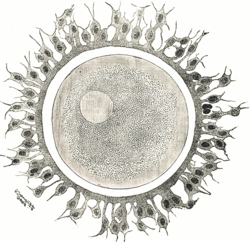A zygote (from Greek ζυγωτός zygōtos "joined" or "yoked", from ζυγοῦν zygoun "to join" or "to yoke")[1] is a eukaryotic cell formed by a fertilization event between two gametes. The zygote's genome is a combination of the DNA in each gamete, and contains all of the genetic information necessary to form a new individual organism.
In multicellular organisms, the zygote is the earliest developmental stage. In humans and most other anisogamous organisms, a zygote is formed when an egg cell is fertilized by a sperm cell. In single-celled organisms, the zygote can divide asexually by mitosis to produce identical offspring.
German zoologists Oscar and Richard Hertwig made some of the first discoveries on animal zygote formation in the late 19th century.
https://en.wikipedia.org/wiki/Zygote
In seed plants, the ovule is the structure that gives rise to and contains the female reproductive cells. It consists of three parts: the integument, forming its outer layer, the nucellus (or remnant of the megasporangium), and the female gametophyte (formed from a haploid megaspore) in its center. The female gametophyte — specifically termed a megagametophyte— is also called the embryo sac in angiosperms. The megagametophyte produces an egg cell for the purpose of fertilization.
The pollen tube releases two sperm nuclei into the ovule. In gymnosperms, fertilization occurs within the archegonia produced by the female gametophyte. While it is possible that several egg cells are present and fertilized, typically only one zygote will develop into a mature embryo as the resources within the seed are limited.[citation needed]
In flowering plants, one sperm nucleus fuses with the egg cell to produce a zygote, the other fuses with the two polar nuclei of the central cell to give rise to the polyploid (typically triploid) endosperm. This double fertilization is unique to flowering plants, although in some other groups the second sperm cell does fuse with another cell in the megagametophyte to produce a second embryo. The plant stores nutrients such as starch, proteins, and oils in the endosperm as a food source for the developing embryo and seedling, serving a similar function to the yolk of animal eggs. The endosperm is also called the albumen of the seed.[citation needed] the zygote then develops into a megasporophyte, which in turn produces one or more megasporangia. The ovule, with the developing megasporophyte, may be described as either tenuinucellate or crassinucellate. The former has either no cells or a single cell layer between the megasporophyte and the epidermal cells, while the latter has multiple cell layers between.[7]
Embryos may be described by a number of terms including Linear (embryos have axile placentation and are longer than broad), or rudimentary (embryos are basal in which the embryo is tiny in relation to the endosperm).[8]
https://en.wikipedia.org/wiki/Ovule
The egg cell, or ovum (plural ova), is the female reproductive cell, or gamete, in most anisogamous organisms (organisms that reproduce sexually with a larger, female gamete and a smaller, male one). The term is used when the female gamete is not capable of movement (non-motile). If the male gamete (sperm) is capable of movement, the type of sexual reproduction is also classified as oogamous. A nonmotile female gamete formed in the oogonium of some algae, fungi, oomycetes, or bryophytes is an oosphere.[1] When fertilized the oosphere becomes the oospore.[clarification needed]
When egg and sperm fuse during fertilisation, a diploid cell (the zygote) is formed, which rapidly grows into a new organism.
| Egg cell | |
|---|---|
 A human egg cell with surrounding corona radiata |
https://en.wikipedia.org/wiki/Egg_cell

No comments:
Post a Comment